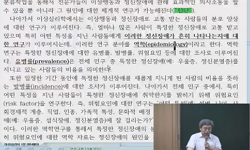김동근은 그간 한국의 현대시를 ‘담론(discourse)’을 주제어로 삼아 탐구해 왔다. 기실 ‘담론’은 문학을 비롯해 인간의 거의 모든 분야를 연구하는 데 매우 중요한 개념이며, 김동근은 시...
http://chineseinput.net/에서 pinyin(병음)방식으로 중국어를 변환할 수 있습니다.
변환된 중국어를 복사하여 사용하시면 됩니다.
- 中文 을 입력하시려면 zhongwen을 입력하시고 space를누르시면됩니다.
- 北京 을 입력하시려면 beijing을 입력하시고 space를 누르시면 됩니다.
한국 현대시의 담론체계와 서정시의 형성 과정에 대한 기호학적 접근―김동근의 정지용과 이상 시에 관한 연구를 중심으로 = Semiotic Approach to the Discourse System and the Formation Process of Lyric Poetry in Modern Korean Poetry
한글로보기https://www.riss.kr/link?id=A108369837
- 저자
- 발행기관
- 학술지명
- 권호사항
-
발행연도
2022
-
작성언어
Korean
- 주제어
-
KDC
810
-
자료형태
학술저널
-
수록면
5-27(23쪽)
- 제공처
-
0
상세조회 -
0
다운로드
부가정보
국문 초록 (Abstract)
김동근은 그간 한국의 현대시를 ‘담론(discourse)’을 주제어로 삼아 탐구해 왔다. 기실 ‘담론’은 문학을 비롯해 인간의 거의 모든 분야를 연구하는 데 매우 중요한 개념이며, 김동근은 시학과 시론의 영역에서 담론의 관여와 생성 국면에 관해 적극적으로 해명한 바 있다. 본고는 김동근의 담론 분석 연구가 강조한 내용을 면밀하게 살펴본 후 핵심적인 견해들을 재구성하고 더 나아가 그 의의를 말하고자 한다. 김동근은 지금 우리가 ‘서정시’라고 부르는 글쓰기 장르의 특성과 그 의미 형성 및 작용을 밝히기 위해 사적인 추적 과정에서 중요한 지점을 찾아내고 연구를 심화해왔다. 특히 김동근은 시문학파(박용철, 김영랑, 정지용)와 모더니즘(김기림, 정지용, 이상 등) 그리고 생명파의 시에 주목하였다. 이러한 그의 연구는 일차적으로 서정시의 다양한 변이형들을 통해 서정시를 정의하기 위함이며, 더 나아가 시학과 시쓰기의 성격을 규명하는 데 유용한 개념적 도구를 마련하기 위함이라고 할 수 있다. 정지용과 이상에 대한 김동근의 관심과 해석은 ‘서정(탈서정)시’, ‘근대(현대)시’, ‘근대성(현대성)’, ‘시적 의미’, 그리고 시에 있어서 ‘화자’와 ‘주체’의 문제 등 흥미로운 논의 지점을 내포한다. 1920년대의 서정시로부터 나름대로의 문제의식을 지니고 시대와 시의 풍경에 대응했던 결과로서 그가 주목한 1930년대의 시는, 그중에서도 정지용과 이상의 비슷하면서도 서로 다른 혹은 상호 대조되는 시적 태도 및 시 텍스트를 산출했다. 본고는 이 두 시인을 기호학의 관점에서 다룬 김동근의 논문을 대상으로 한국 근ㆍ현대시의 형성ㆍ발전 단계에 있어 중요한 징후를 포착하는 기회를 얻을 수 있을 것이다.
다국어 초록 (Multilingual Abstract)
Kim Dong-geun has been exploring modern Korean poetry with ‘discourse’ as the keyword of his studies. In fact, ‘discourse’ is a very important concept in studying almost all human's fields of culture, including literature, and Kim Dong-geun ha...
Kim Dong-geun has been exploring modern Korean poetry with ‘discourse’ as the keyword of his studies. In fact, ‘discourse’ is a very important concept in studying almost all human's fields of culture, including literature, and Kim Dong-geun has actively explained the involvement and creation of discourse in the field of poetry and poetry. This study aims to reconstruct key views after closely examining the contents emphasized by Kim Dong-geun's discourse analysis results submitted so far, and furthermore, to express its significance. Kim Dong-geun has found important points in the historical tracking process and deepened his study to reveal the characteristics, meaning formation, and action of the writing genre we now call lyric poetry. In particular, he paid attention to poems of Park Yong-cheol, Kim Young-rang, Jeong Ji-yong, Kim Ki-rim, and Lee Sang, etc. His study is primarily aimed at defining lyric poetry through various variations in lyric poetry, and furthermore, it can be said to provide a useful conceptual tool for identifying the characters of poetry and poetry writing. Kim Dong-geun's interest and interpretation of Jeong Ji-yong and Lee Sang implies interesting points of discussion, such as ‘lyric(or anti-lyric, post-lyric)Poetry’, ‘Modernity’, ‘Poetic Meaning’, and the issue of speaker and subject in poetry(interpretation). The poetry of the 1930s is the result of responding to the landscape of the times and poetry with a critical mind in its own way from the lyric poetry of the 1920s. Among them, Jeong Ji-yong and Lee Sang's poems, which he paid attention to, produced poetic attitudes and poetic texts that were similar to each other but different from each other or contrasted with each other. This study targets semiotic analysis papers on these two poets. This article will provide an opportunity to capture important signs in the stage of formation and development of modern Korean poetry.
목차 (Table of Contents)
- Ⅰ. 서정시, 담론 그리고 기호학
- Ⅱ. 1920-30년대 시론과 한국적 서정시의 형성
- Ⅲ. 정지용 시의 공간체계와 의미 형성에 관한 논의
- Ⅳ. 이상 시의 작시 논리와 의미 형성에 관한 논의
- Ⅴ. 결론을 대신하여
- Ⅰ. 서정시, 담론 그리고 기호학
- Ⅱ. 1920-30년대 시론과 한국적 서정시의 형성
- Ⅲ. 정지용 시의 공간체계와 의미 형성에 관한 논의
- Ⅳ. 이상 시의 작시 논리와 의미 형성에 관한 논의
- Ⅴ. 결론을 대신하여
동일학술지(권/호) 다른 논문
-
- 한국지역문학회
- 남기택
- 2022
-
시네키즘적 통찰과 사랑의 담론 체계*―김동근의 기호론적 연구를 중심으로
- 한국지역문학회
- 정민구
- 2022
-
- 한국지역문학회
- 최명표
- 2022
-
주체적 동행을 갈망하는 노스탤지어의 기호들—김동근의 시론과 1930년대 시문학사
- 한국지역문학회
- 김은정
- 2022




 RISS
RISS






